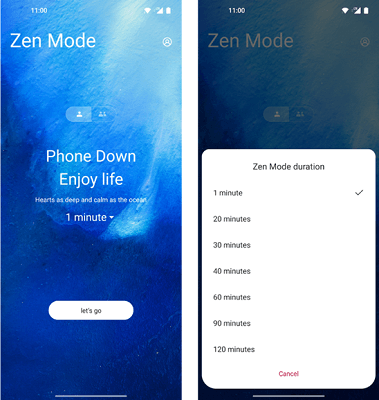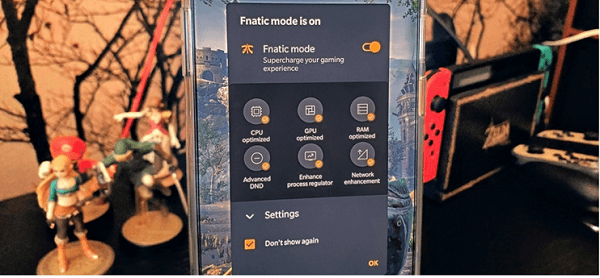Oxygen OS
OnePlus, a Chinese smartphone maker, created Oxygen OS, an Android-based operating system. Oxygen OS was first developed in 2015 to deliver a clean, quick, and configurable user experience on OnePlus smartphones. It strives to provide a near-stock Android experience while adding features and optimizations to improve speed and user pleasure.
Below are the key features of this Oxygen OS:
- Customization and User Interface: Oxygen OS has a clean and basic user experience that is similar to native Android. It prioritizes fluid animations, rapid app launches, and simple navigation. OnePlus smartphones running Oxygen OS provide a variety of customization options, including customizable app icons, accent colors, and system themes, allowing users to personalize their devices to their liking.
- Gestures and Navigation: To improve user engagement, Oxygen OS supports a variety of gestures. Users may use gestures to navigate across apps, use the camera or torch with simple motions, and customize gesture controls for specific purposes.
- Performance Optimizations: Oxygen OS prioritizes quick and smooth performance. It includes enhancements to increase app startup speed, reduce touch latency, and reduce background resource use. It also includes a number of performance-enhancing features, including RAM management, program prioritization, and background process control.
Oxygen OS received positive feedback for its user-friendly design, performance enhancements, and the balance it strikes between stock Android and additional customization choices.

- Reading Mode: The Reading Mode function in Oxygen OS adapts the display to provide a more pleasant reading experience. To imitate a paper-like reading experience, it decreases blue light output, optimizes the contrast, and fine-tunes the display settings.
- Gaming Mode: Oxygen OS has a Gaming Mode that improves gaming on OnePlus smartphones. It includes features such as notification filtering, network bandwidth redirection to the game, and system resource optimization to ensure seamless gaming.
- App Locker and Parallel Apps: Oxygen OS allows users to clone certain programs, allowing them to utilize many accounts or profiles on the same device at the same time. It also has an App Locker feature, which lets users protect particular applications using a PIN, pattern, or fingerprint identification for increased privacy and security.
- Quick Settings: Oxygen OS has a customizable Quick Settings panel, which helps users quickly access commonly used toggles and shortcuts. It also has a Shelf feature, which can be accessed by swiping right on the home screen and gives a place for widgets, app shortcuts, and information like recent contacts, weather updates, and commonly used applications.
- Updates and Community Feedback: OnePlus provides Oxygen OS software updates on a regular basis, offering customers bug fixes, security patches, and new features. In addition, the firm actively interacts with its user community, soliciting input and recommendations for enhancing the operating system.
- Zen Mode: Oxygen OS offers a Zen Mode function that allows users to disconnect from their devices and decrease digital distractions. When Zen Mode is enabled, the device is locked for a certain amount of time, during which users may only make emergency calls and utilize the camera. It helps users to withdraw and focus on other tasks without being interrupted.

- Enhanced Camera App: OnePlus smartphones running Oxygen OS frequently have improved camera software with additional capabilities and controls for photographers. It may have manual controls for modifying parameters like as ISO, shutter speed, and white balance, as well as several shooting modes and filters to improve the photographic experience.
- System-wide Dark Mode: Oxygen OS includes a system-wide Dark Mode that may be enabled to change the color palette of the user interface. This not only gives the device a more visually pleasing appearance, but it may also reduce eye strain, conserve battery life on smartphones with OLED panels, and provide a more pleasant viewing experience in low-light circumstances.
- OnePlus Gestures: Oxygen OS includes its own set of simple gestures for navigating the device. Swiping up from the bottom center to reach the home screen, or swiping up from the bottom borders to access recent applications, are alternatives to standard navigation buttons.
- Security and Privacy: Oxygen OS prioritizes user privacy and security. It has features including an app permission manager, which lets users to govern and manage app access to important information, and a file-based encryption system, which secures user data. Furthermore, OnePlus releases security updates on a regular basis to patch vulnerabilities and assure customer safety.
- Always-On Display: An Always-On Display (AOD) feature is available on some OnePlus smartphones running Oxygen OS. while enabled, the AOD displays important information like the time, date, notifications, and battery status even while the device is in sleep mode. This function gives ease and rapid access to information without requiring the device to be unlocked.
- Launcher: The OnePlus Launcher comes with Oxygen OS and serves as the device's default launcher for the home screen and app drawer. The launcher provides access to app shortcuts, app icon customization, and the ability to organize programs into folders. It also supports dynamic wallpaper and the option to hide specific apps from the app drawer.
- Connect: Oxygen OS includes OnePlus Connect, a companion software for Android and iOS devices. Users may use the OnePlus link to link their OnePlus device to their smartphone and perform different functions from their smartphone, such as volume control, media playback, and device locking.
- Zen Mode 2.0: Zen Mode 2.0, an enhanced version of the original Zen Mode, is now available in Oxygen OS. Zen Mode 2.0 extends the mode's duration from 1 to 120 minutes, allowing users to select the period that best matches their requirements. It also adds additional themes and noises to the relaxing experience.
While these features and functions were previously available in Oxygen OS, OnePlus has migrated to a single operating system known as "Oxygen OS with ColorOS," beginning with the OnePlus 9 series in 2021. This modification brings Oxygen OS more in line with OPPO's ColorOS, another Android-based operating system. The unified operating system seeks to provide consumers with the best Oxygen OS and ColorOS while maintaining a consistent experience across OnePlus and OPPO devices.
Apart from the above-mentioned features, an Oxygen OS may include the following features as well:
- RAM Boost: The RAM Boost function in Oxygen OS intelligently optimizes the device's RAM utilization. It analyses user behavior and app usage trends to preload commonly used apps into memory, enabling quicker app switching and more seamless multitasking.
- Fnatic Mode: Oxygen OS now has Fnatic Mode, which is built exclusively for gamers. Fnatic Mode disables incoming calls, alerts, and other distractions, letting gamers concentrate solely on their games. It also prioritizes game system resources, optimizing performance for lag-free gameplay.

- Live Captions: Oxygen OS has Live Caption, a function that offers real-time subtitles for media material playing on the device. It analyses audio streams and generates subtitles on a device, making movies, podcasts, and other media more accessible to individuals with hearing difficulties.
- Game Space: OnePlus Game Space, a dedicated center for gamers to manage their gaming experience, is now available in Oxygen OS. Game Space offers a centralized spot for organizing installed games and easy access to gaming settings, optimization tools, and gaming news, ensuring that users have all the resources they need for an immersive gaming experience.
- Minimal Bloatware: Oxygen OS is well-known for its lack of bloatware and simplified approach to pre-installed apps. OnePlus devices come with a small amount of pre-installed apps, concentrating on critical features and capabilities rather than overloading consumers with extraneous software. This method aids in keeping the user interface clean and clear.
- Battery Management: Oxygen OS provides proactive battery management functions to optimize power usage. To increase battery life, it analyses usage patterns and adjusts power distribution. This includes features such as Sleep Standby Optimization, which decreases power usage during inactive periods, and App Power Saving, which limits the number of power-hungry apps that may run in the background.
- File Dash: Oxygen OS has File Dash, a quick and easy file-sharing function. Users may use File Dash to transfer files, documents, and media wirelessly between OnePlus devices or to adjacent devices that support the File Dash protocol, removing the need for extra cords or third-party programs.
While Oxygen OS is built on the Android platform, its emphasis on performance, customization, and OnePlus-specific features, as well as community interaction and frequent updates, distinguishes it from other Android-based operating systems. These distinguishing features add to the one-of-a-kind experience provided by Oxygen OS on OnePlus smartphones.
Oxygen OS is designed to integrate flawlessly with OnePlus hardware, resulting in an enhanced user experience. To bring better performance and functionality, the operating system is intended to make use of the particular hardware capabilities of OnePlus devices, such as display technologies, camera systems, and audio upgrades.
While Oxygen OS has several features, it has some disadvantages, which can be discussed as follows:
- Reduced Customization in latest versions: With the OnePlus 9 series, the company moved to a unified operating system termed "Oxygen OS with ColorOS." This modification pushed Oxygen OS closer to OPPO's ColorOS, and some users saw a reduction in the extent of personalization and distinctive features formerly associated with Oxygen OS.
- Less Stock Android Experience: While Oxygen OS promises to give a near-stock Android experience, some users believe that newer versions have drifted away from the original Android's simplicity and minimalism. The increased incorporation of OnePlus-specific features and UI upgrades has resulted in a deviation from the pure stock Android experience preferred by some customers.
- Limited availability to Non-OnePlus Users: Oxygen OS was created specifically for OnePlus devices and is not widely accessible for other Android handsets. This implies that those who like Oxygen OS may be constrained to purchasing OnePlus smartphones, limiting their hardware options.
- Varying Updates: While OnePlus is known for offering fast software upgrades, the frequency and consistency of updates might vary amongst models. Some older or low-cost models may not receive as regular upgrades as flagship smartphones, resulting in a fragmented user experience in terms of functionality and security fixes.
- Smaller User Community: While OnePlus has a devoted and engaged user base, it is modest in comparison to other big Android companies. This may have an effect on the availability of user-generated content, such as custom ROMs, themes, and community support, which may be more widespread in bigger Android communities.
- Compatibility issues: Despite the fact that Oxygen OS is built on Android, some customers have noticed occasional app compatibility concerns. Minor glitches to app crashes or instability are examples of these difficulties. OnePlus, on the other hand, usually strives to resolve these difficulties through software upgrades.
These disadvantages mentioned above are subjective and may not affect all users.
- Learning Curve: Some users may encounter a learning curve when switching from another Android-based operating system to Oxygen OS. The UI and navigation may change somewhat, necessitating some adaptations to the OnePlus-specific features and customization possibilities.
- Availability of Accessories: While OnePlus smartphones are recognized for being compatible with certified OnePlus accessories, the availability of these accessories varies by area. When compared to more commonly accessible third-party solutions, some customers may find it difficult to get genuine OnePlus accessories.
- Potential Software Bugs: Oxygen OS, like any other software, is susceptible to software faults and malfunctions. While OnePlus aims to deliver stable and dependable software, customers may have small difficulties requiring bug patches or upgrades to resolve.
Note: The benefits and drawbacks of Oxygen OS vary based on personal tastes, unique device types, and the version of Oxygen OS utilized. When deciding which operating system best meets your requirements and interests, it's always a good idea to investigate and consider these aspects.
|

 For Videos Join Our Youtube Channel: Join Now
For Videos Join Our Youtube Channel: Join Now











